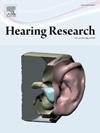使用人工耳蜗电极进行阻抗光谱分析的简单电路模型
IF 2.5
2区 医学
Q1 AUDIOLOGY & SPEECH-LANGUAGE PATHOLOGY
引用次数: 0
摘要
虽然人工耳蜗是一种成熟的听力恢复方法,但它也有其局限性,例如由于电极阵列周围组织的生长,会导致电流扩散增大和频率分辨率降低。人工耳蜗的阻抗测量已成为术中和术后诊断人工耳蜗状态的通用工具。然而,大多数临床设备使用植入体中已有的电流脉冲刺激,分析时域电压响应并沿耳蜗扩散。要充分发挥阻抗光谱在区分细胞类型方面的潜力,需要在更大的频率范围内进行测量。本研究提出了一种简单的电气等效电路,用于使用双极配置的人工耳蜗进行阻抗光谱分析。该电学等效电路通过比较两种非线性双电层模型(科尔-科尔模型和施万-法拉第模型),描述了耳蜗植入电极的电学特性及其在电极-电解质界面的电化学行为。该模型针对四个不同制造商生产的四个人工耳蜗电极(MED-EL FlexSoft、AB HiFocus SlimJ、Oticon EVO 和 Cochlear Nucleus CI622)进行了验证,并通过 5 Hz 和 13 MHz 之间的阻抗谱进行了表征。将来,这种电气等效电路可能有助于从阻抗频谱测量中提取参数,用于区分人工耳蜗电极周围的细胞类型。本文章由计算机程序翻译,如有差异,请以英文原文为准。
A simple electrical circuit model for impedance spectroscopy with cochlear implant electrodes
Although cochlear implants are an established method of restoring hearing, they can have limitations such as increasing current spread and decreasing frequency resolution due to tissue growth around the electrode array. Impedance measurements in cochlear implants have become a versatile tool for intra- and post-operative diagnosis of cochlear implant state. However, most clinical devices use current pulse stimulation already available in the implants and analyze the voltage response in the time-domain and spread along the cochlea. To use the full potential of impedance spectroscopy in differentiating cell types, measurement over an extended frequency range is required. This study presents a simple electrical equivalent circuit for impedance spectroscopy with cochlear implants in a 2-pole configuration. The electrical equivalent circuit describes the electrical properties of the cochlear implant electrode and its electrochemical behavior at the electrode-electrolyte interface by comparing two non-linear bilayer models, Cole-Cole and Schwan-Faraday. The model is validated for four cochlear implant electrodes from four different manufacturers (MED-EL FlexSoft, AB HiFocus SlimJ, Oticon EVO, Cochlear Nucleus CI622) characterized by impedance spectroscopy between 5 Hz and 13 MHz. In the future, this electrical equivalent circuit may help to extract parameters for differentiating cell types around the cochlear implant electrode from an impedance spectroscopic measurement.
求助全文
通过发布文献求助,成功后即可免费获取论文全文。
去求助
来源期刊

Hearing Research
医学-耳鼻喉科学
CiteScore
5.30
自引率
14.30%
发文量
163
审稿时长
75 days
期刊介绍:
The aim of the journal is to provide a forum for papers concerned with basic peripheral and central auditory mechanisms. Emphasis is on experimental and clinical studies, but theoretical and methodological papers will also be considered. The journal publishes original research papers, review and mini- review articles, rapid communications, method/protocol and perspective articles.
Papers submitted should deal with auditory anatomy, physiology, psychophysics, imaging, modeling and behavioural studies in animals and humans, as well as hearing aids and cochlear implants. Papers dealing with the vestibular system are also considered for publication. Papers on comparative aspects of hearing and on effects of drugs and environmental contaminants on hearing function will also be considered. Clinical papers will be accepted when they contribute to the understanding of normal and pathological hearing functions.
 求助内容:
求助内容: 应助结果提醒方式:
应助结果提醒方式:


